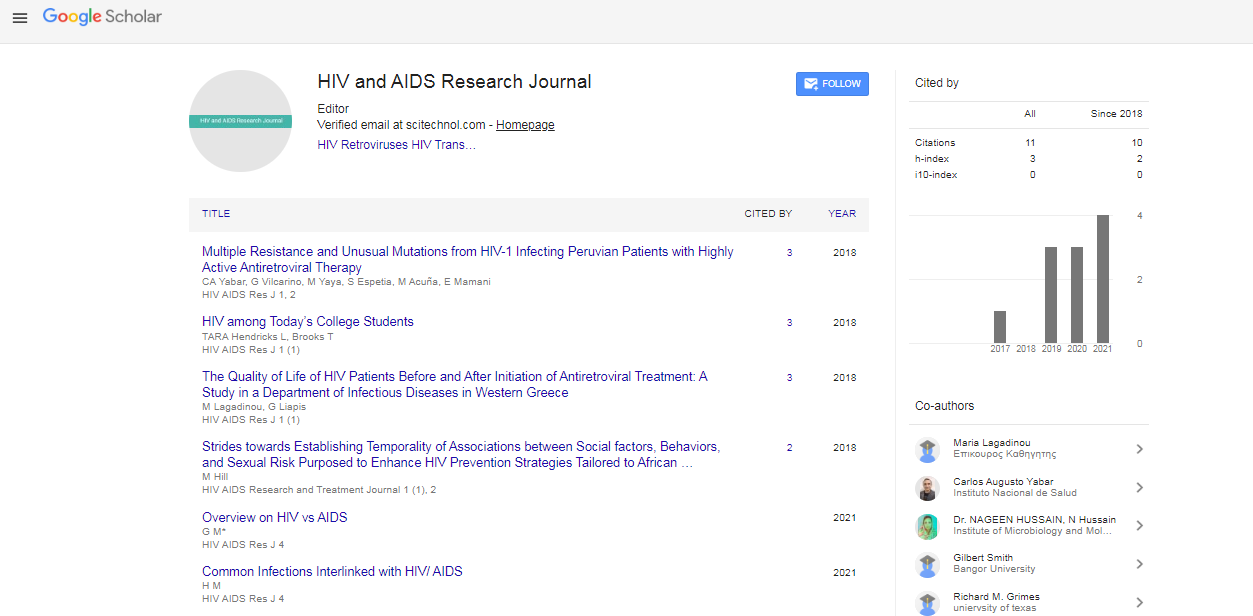Commentary, Hiv Aids Res J Vol: 6 Issue: 4
Deciphering HIV Transmission: Routes, Risks and Preventive Strategies
David Samuel*
1Department of General Medicine, Capital Medical University, Beijing, China
*Corresponding Author: David Samuel,
Department of General Medicine, Capital
Medical University, Beijing, China
E-mail: Davidsam90k@gmail.com
Received date: 04 December, 2023, Manuscript No. HARJ-24-124115;
Editor assigned date: 06 December, 2023, PreQC No. HARJ-24-124115 (PQ);
Reviewed date: 20 December, 2023, QC No. HARJ-24-124115;
Revised date: 28 December, 2023, Manuscript No. HARJ-24-124115 (R);
Published date: 05 January, 2024 DOI: 10.4172/Harj.1000131
Citation: Samuel D (2024) Deciphering HIV Transmission: Routes, Risks and Preventive Strategies. HIV AIDS Res J 6:4.
Description
Human Immunodeficiency Virus (HIV) transmission remains a critical concern globally, contributing to the widespread prevalence of Acquired Immunodeficiency Syndrome (AIDS). Understanding the various routes of transmission is pivotal in implementing effective preventive measures to curb the spread of this infectious virus.
Routes of HIV transmission
HIV can be transmitted through various bodily fluids, primarily:
Blood-to-blood contact: HIV can spread through exposure to contaminated blood or blood products. This mode of transmission was historically significant through blood transfusions before stringent screening protocols were established. Additionally, sharing needles and syringes among intravenous drug users presents a high risk of HIV transmission.
Perinatal transmission: HIV can be transmitted from an infected mother to her child during pregnancy, childbirth, or breastfeeding. However, effective interventions such as Antiretroviral Therapy (ART) for the mother during pregnancy and cesarean section delivery significantly reduce the risk of transmission to the newborn.
Occupational exposure: Healthcare workers or individuals in professions involving exposure to potentially infected blood or bodily fluids are at risk of HIV transmission if proper precautions are not taken. Strict adherence to infection control measures and the use of protective equipment significantly mitigate this risk.
Factors influencing transmission
Several factors impact the likelihood of HIV transmission:
Viral load: Individuals with higher viral loads, especially during acute infection or advanced disease stages, are more infectious. Elevated viral loads significantly increase the risk of transmission.
Stage of infection: Acute HIV infection, characterized by high viral replication and elevated viral load, poses a significantly higher risk of transmission than during the chronic phase.
Coinfections: Presence of other STIs or genital ulcers can facilitate the entry and transmission of HIV, amplifying the risk.
Preventive strategies
Education and awareness form the cornerstone of HIV prevention. Implementing a combination of preventive strategies significantly reduces transmission rates:
Needle exchange programs: Implementing harm reduction strategies, such as needle exchange programs, provides sterile syringes to injection drug users, reducing the risk of HIV transmission through contaminated needles.
Antiretroviral Therapy (ART): Prompt initiation of ART in individuals living with HIV not only improves their health but also drastically reduces the viral load, thereby decreasing the risk of transmitting the virus to others.
Pre-Exposure Prophylaxis (PrEP): PrEP involves taking antiretroviral drugs before potential exposure to HIV, significantly reducing the risk of infection, particularly for individuals at high risk, such as serodiscordant couples or individuals engaging in high-risk behaviors.
Preventive treatment for mothers and children: Administering antiretroviral medications to pregnant women living with HIV, along with appropriate obstetric care, greatly reduces the risk of mother-tochild transmission.
Conclusion
HIV transmission encompasses various modes influenced by viral factors, behavioral practices, and preventive strategies. Comprehensive and targeted interventions, including safe sex practices, needle exchange programs, early diagnosis, and the use of antiretroviral medications, play pivotal roles in curbing the transmission of HIV. The pursuit of eradicating HIV transmission demands a multifaceted approach, including education, access to healthcare services, and continued research to develop innovative preventive measures. Heightened awareness, coupled with the adoption of preventive strategies, remains crucial in averting new HIV infections and combating this global health challenge.
 Spanish
Spanish  Chinese
Chinese  Russian
Russian  German
German  French
French  Japanese
Japanese  Portuguese
Portuguese  Hindi
Hindi 